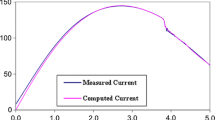Abstract
The formation of a peaked bell-shaped profile of the electron density n e (r) in the T-11M tokamak (B t=1 T, R/a = 0.7/0.2 m, I p = 100 kA, t shot ≤ 300 ms, Li and C limiters) was observed in Li experiments carried out in the near-plateau collisionality regime (the collisionality parameter at one-half of the minor radius was v* ≥ 0.5) under the conditions of low hydrogen recycling and intense hydrogen influx from the plasma edge. It is well known that peaked n e (r) profiles are observed in collisionless regimes at v* values as low as 10−1–10−2 or in impurity-contaminated discharges, in which this effect can be attributed to the impurity accumulation on the plasma column axis. Moreover, a bell-shaped n e (r) profile in discharges with low n e can result from the ionization of hydrogen atoms at the column axis, where they arrive from the plasma edge due to cascade charge-exchange. In quasi-steady lithium discharges in T-11M, however, peaked n e (r) profiles were observed at a relatively high central electron density n e (0) and relatively high collision frequency, such that the influence of impurities on the n e (r) profile could be ignored (Z eff = 1.1±0.1). To explain this effect, one has to assume that the pinching of hydrogen ions in T-11M is anomalous. The lower estimate of the observed pinch velocity is 4 ± 1 m/s, which is three to five times higher than the velocity of the neoclassical (Ware) pinch, characteristic of these conditions. The work is devoted to the experimental study of this effect.
Similar content being viewed by others
References
V. A. Evtikhin, I. E. Lyublinski, A. V. Vertkov, et al., Plasma Sci. Technol. 6, 2291 (2004).
L. Garzotti, X. Garbet, P. Mantica, et al., Nucl. Fusion 43, 1829 (2003).
G. T. Hoang, C. Bourdelle, B. Pégourié, et al., Phys. Rev. Lett. 90, 155002 (2003).
A. Zabolotsky, H. Weisen, and TCV Team, Plasma Phys. Controlled Fusion 45, 735 (2003).
I. Furno and H. Weisenet, Phys. Plasmas 10, 2422 (2003).
V. B. Lazarev, E. A. Azizov, A. G. Alekseyev, et al., in Proceedings of the 30 EPS Conference on Controlled Fusion and Plasma Physics, St. Petersburg, 2003, ECA 27A, 3.162 (2003).
M. J. Baldwin, R. P. Doerner, S. C. Luckhardt, et al., in Proceedings of the 43rd Annual Meeting of APS, Division of Plasma Physics, Long Beach, CA, 2001, report no. CP1 25.
E. P. Gorbunov, S. V. Mirnov, and D. S. Parfenov, Nucl. Fusion 11, 433 (1973).
V. F. Shevchenko, A. A. Petrov, V. G. Petrov, and Yu. A. Chaplygin, Fiz. Plazmy 22, 32 (1996) [Plasma Phys. Rep. 22, 28 (1996)].
V. G. Petrov, A. A. Petrov, A. Yu. Malyshev, et al., Fiz. Plazmy 30, 129 (2004) [Plasma Phys. Rep. 30, 111 (2004)].
S. E. Segre, Plasma Phys. Controlled Fusion 41, R57 (1999).
E. P. Gorbunov, V. F. Denisov, V. G. Merezhkin, et al., in Proceedings of the 10th All-Russian Conference on Diagnostics of High-Temperature Plasmas, Troitsk, 2003, report no. B6.
V. G. Merezhkin, Sigma+: A Testing Program for OH Discharge in a Tokamak, http://www.tokamak.fusion.ru
L. A. Artsimovich, A. V. Glukhov, and M. P. Petrov, Pis’ma Zh. Éksp. Teor. Fiz. 11, 449 (1970) [JETP Lett. 11, 304 (1970)].
B. Coppi and C. Spight, Phys. Rev. Lett. 41, 551 (1978).
W. M. Tang, G. Rewoldt, and Liu Chen, Phys. Fluids 29, 3715 (1986).
V. V. Yan’kov, Pis’ma Zh. Éksp. Teor. Fiz. 60, 169 (1994) [JETP Lett. 60, 171 (1994)].
M. B. Isichenko, A. V. Gruzinov, and P. H. Diamond, Phys. Rev. Lett. 74, 4436 (1996).
D. R. Baker and M. N. Rosenbluth, Phys. Plasmas 5, 2936 (1998).
F. Miskane, X. Garbet, A. Dezairi, and D. Saifaoui, Phys. Plasmas 7, 4197 (2000).
Author information
Authors and Affiliations
Additional information
Original Russian Text © V.G. Petrov, A.A. Petrov, É.A. Azizov, A.G. Alekseev, V.B. Lazarev, V.G. Merezhkin, S.V. Mirnov, 2007, published in Fizika Plazmy, 2007, Vol. 33, No. 9, pp. 771–781.
Rights and permissions
About this article
Cite this article
Petrov, V.G., Petrov, A.A., Azizov, É.A. et al. Anomalous pinch in the T-11M tokamak in an enhanced-collisionality regime. Plasma Phys. Rep. 33, 703–713 (2007). https://doi.org/10.1134/S1063780X07090012
Received:
Accepted:
Issue Date:
DOI: https://doi.org/10.1134/S1063780X07090012



